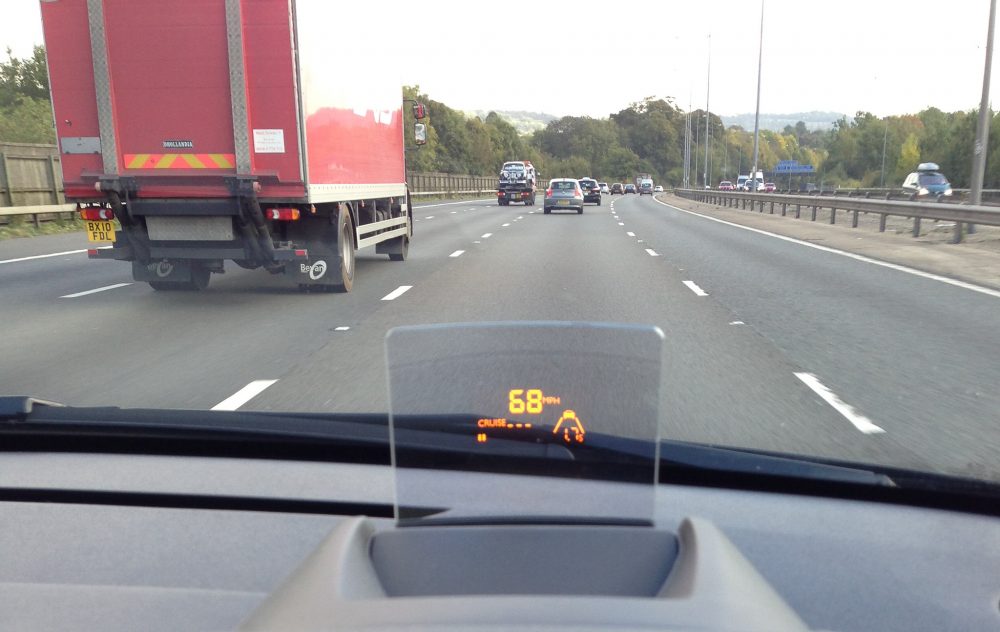How Do Head-Up Displays Work?

Photo: Jay Galvin via CC
If you’ve ever wondered how head-up displays work, you’re in the right place. Get the scoop on this fascinating technology — and learn a bit about reality-enabled HUDs that will soon debut on upcoming car models.
Safe and Sophisticated: Meet the Cadillac XT6
How a head-up display works
Stay focused on what’s ahead with an innovative Head-Up Display in the All-New #BuickEnvision Avenir. pic.twitter.com/e5j7rBX3Qu
— Buick (@Buick) June 24, 2021
Per Motor Trend’s Stefan Ogbac, there are two types of head-up displays. One projects driving data onto the car’s windshield, while the other projects the display onto a small screen called a “combiner” that pops out above the instrument cluster.
Windshield-projection HUDs rely on a projector that’s built into the dashboard, as Road and Track’s Blake Rong explains. The projector transfers the image to the windshield via a system of mirrors. These mirrors enlarge and flip the image so the driving info displays right-side-up when you view it on the windshield. HUDs typically have a toggle switch somewhere on the dash that lets you adjust where the image projects. That way, you can position the display in the least distracting place on the windshield.
Systems that project the image onto a plastic screen instead of the windshield work similarly. This type of HUD is more cost-effective for automakers to add to car models because it uses fewer mirrors. Another advantage of this design is that it’s more compatible with a variety of windshield designs. This means that it delivers a more consistent projection quality no matter how curved the windshield is.
Beyond HUD tech
Augmented Reality Driving Assistance will be a key component of the driving experience in @Cadillac Lyriq car #CES2021 #CES2021ECH #Automotive #AR #drivingassistance pic.twitter.com/IO8QPhkXdz
— Nicolas Diacono (@nincoroby) January 12, 2021
No matter which design you go with, an HUD is a smart add-on feature to choose when shopping for a new vehicle. But HUDs aren’t the only type of technology that automakers are exploring as they seek to fine-tune their lineups’ driver-assist tools. Augmented reality HUDs appear to be the next big thing. Many manufacturers are offering this technology on upcoming products, from the Cadillac Lyriq to the Hyundai Ioniq 5.
This new breed of HUD is a bit different than a conventional HUD, mainly in that it visualizes driver-assist data and other necessary driving info from the driver’s perspective. Not only can it display speed, navigation, and warning signal data, but it can also communicate additional information in a more nuanced way by overlaying digital objects onto physical ones. For instance, AR-enabled HUDs can virtually project navigational directions onto the road ahead, as TechHQ’s Haris Elias shares.
Need an HUD-equipped vehicle? Check out the shiny new 2021 Buick Envision. Then get the scoop on the new Kia EV6, which offers an AR-enabled HUD system, among other cool features.
Envision a Safer Future: Find the right Buick Envision for you

Whitney Russell resides in Dayton, though her spirit can be found beach-bumming in Puerto Rico (the land of her half-Puerto Rican heritage). When not crafting car-related content, she can be found chasing after the most amazing toddler in the world, watching her “beaver” of a husband build amazing woodworking projects, hanging out with two crazy dogs, and visiting family and friends. She also enjoys traveling, crafting, and binge-watching period dramas when time allows. See more articles by Whitney.

